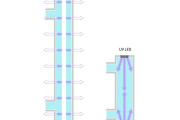The merge between Taiwan’s two largest LED manufacturers Epistar and FOREPI has established the trend of forming alliances in the country’s LED industry, and the dawning of the oligopoly market. Since the two company’s merge on June 30, 2014, FOREPI has received LED lighting OEM orders from Epistar. No further restructures and adjustments have been made so far. What were the actual circumstances behind the birth of the new Epistar? What exactly happened behind the scenes? In this in-depth interview with Epistar Spokesman Rider Chang, LEDinside probes into the company’s mindset during the recent merge.
Epistar’s major businesses LED lighting and backlight have seen strong demands this year. Order visibility has been high with consolidated revenue in June 2014 setting a new historical record of NT $2.82 billion (US $90 million). The company’s 2Q14 revenue was also up 30 percent compared to the previous quarter. FOREPI’s revenue last month were also up to NT $500 million, and aims to turnaround losses by 3Q14. The market has been concerned about the impact from the merge between the two companies, and China’s largest LED chip manufacturer San’an Opto’s next move.
 |
|
Epistar CFO Rider Chang. (Photo Courtesy of Epistar) |
Current status quo to be maintained after merge
FOREPI has received Epistar OEM orders starting this month, but only in small volumes, said Chang during the interview. Although, Epistar has absorbed all of FOREPI’s production capacity, the company has to serve existing client base, and is only capable of making 30 percent of production capacity available for Epistar’s OEM orders. It might still not be enough to fill Epistar’s 300,000 LED pcs production shortage, or sufficiently meet growing number of clients in 2015.
“Before acquiring approval from stockholders, the company will be unable to carry out the merge,” said Chang. Currently, the two companies are unable to implement further integration. Under the current OEM model, FOREPI has the right to decide how much production capacity it can offer to Epistar. FOREPI should have reasonable capacity to meet current client demands, and the current status quo will be kept after the merge. Further integration will be rolled out after the stockholder meeting on Sept., 1, 2014. At the same time, the two parties will also try to further understand the each other’s product features. Epistar estimates after the merge, FOREPI’s monthly revenue during peak seasons can grow from NT $500 million to more than NT $700 million.
Three reasons why FOREPI was chosen as the ideal candidate
Although, Epistar has successfully “married” FOREPI, many in the industry have wondered why other companies did not make the cut. Other Taiwanese manufacturers also have high quality production capacity, human resources and other company resources. Epistar admitted it did evaluate other Taiwanese and Chinese LED manufacturers before sticking to FOREPI, said Chang. So why was FOREPI chosen as the potential “mate”?
Three major factors were involved in the decision-making process, noted Chang. Epistar has strong LED demands and requires short “time to market” to quickly generate benefits. Secondly, the costs involved in the acquisition was acceptable for the company. The last reason is stockholders and employees were more willing to cooperate, which greatly lowers the risks, and speeds up the “synergy” process.
The “synergy” process has a wide impact including on client list. For instance, Epistar’s clients come from all over the world, and FOREPI too has many international clients. In comparison to other Taiwanese companies that might target the Chinese market or specific clients that overlap with Epistar’s client base, the two company’s cooperation will bring multiplies benefits. There are more advantages and benefits by combining the two companies’ client portfolio. In addition, Epistar believes FOREPI has better financial structures, even though it has poor profit margins, the company’s net loss is only about NT $1.8 billion with debt asset ratio slightly over 30 percent. The company also has assets worth NT $20 billion, which reduces the impact the acquisition will have on Epistar’s finances.
Swapping FOREPI shares for Epistar offers way out for San’an Opto
San’an Opto did not nominate a chairman candidate during FOREPI’s stockholder meeting in June 2014. According to market rumors, the main reason was because San’an Opto did not want to recognize FOREPI’s losses. Under accounting principles, San’an Opto will not be affected by FOREPI’s losses if the Chinese company members are not FOREPI’s chairman, and possesses less than 20 percent shares.
The cooperation between the Taiwanese and Chinese manufacturer through San’an Opto’s stock investments failed to create benefits for the two sides. The Chinese chip maker followed Taiwan’s Industrial Development Bureau, a division of Ministry of Economic Affair’s (MOEA), “four no policies,” which included barring the Chinese company from interfering with FOREPI management, effectively blocking San’an Opto from influencing the Taiwanese counterpart in any way. Moreover, the Taiwanese manufacturer has to consider the remaining shareholders rights, who hold the remaining 80 percent stock shares. In reality, the two companies are direct competitors, and with less than 20 percent stake it is difficult for synergy to take place. For FOREPI, the business investment strategy is just a phase. If reasons for cooperation are no longer present or beneficial then the company must search for new partners from the stockholders and employees perspective.
San’an Opto has not released any info about swapping FOREPI stocks for Epistar. What will happen if San’an Opto is unwilling to convert its 19.77 percent stake in FOREPI for Epistar shares? San’an Opto has the right to object at the shareholder meeting, and FOREPI would have to repurchase San’an Opto’s shares, analyzed Chang. The repurchase price can be negotiated between the two companies, or based on court rulings. But if San’an Opto fails to object prior to the stock conversion deadline, all the stocks will be automatically swapped into Epistar shares. Thus, San’an Opto will become an Epistar shareholder.
The conversion of stocks will act as a “way out” for San’an Opto, noted Chang. The Chinese LED manufacturer’s acquisition of FOREPI shares through private-equity imposes a three year lockdown period, after the period depending on FOREPI’s profitability, the company might not be able to issue the stocks publicly. San’an Opto will be faced with the risks of losing its investments in the Taiwanese company. It would be more beneficial if San’an Opto swaps its shares for Epistar, since it would give the company rights to sell the former FOREPI shares. Some industry insiders are concerned San’an Opto could purchase Epistar shares through foreign investors, but Chang believed under Taiwan’s stringent regulations this kind of investment method would not be recognized legally.
Epistar management eyes global market as strong demands pour in from international manufacturers
Epistar’s merge with FOREPI will also help the company improve employee quality to meet new demands from major international manufacturers. Even if the company is unable to fill the production gap this year, by displaying sincerity in resolving the issue, clients’ would have higher levels of trust, and be more willing to place more orders. Currently, LED lighting accounts for 25 percent to 30 percent of Epistar products, while backlight still accounts for the majority 40 to 45 percent. Displays make up 10 to 15 percent of products manufactured, while automotive lighting is a mere five to 10 percent. Chang projected the company’s 3Q14 backlight demand will drop slightly, and some of its backlight production capacity will be transferred to lighting to meet client demands.
As for MOCVD equipments, Epistar plans to add 40 MOCVDs in 2014, including in both Taiwan and Chinese factories. This will bring total MOCVD equipments to 390, and covers AlInGaN LED applications. Additional 103 MOCVD equipment from FOREPI will bring total equipment to 500 in 2014. Although, the company has the world’s largest LED chip production capacity, Epistar’s global market share is only about 20 percent, and the company is considering production expansion in 2015.
In the past, Epistar has merged many times with other companies to distribute risks. Different equipments have been distributed to different companies, but after acquiring Huga Optotech, the company has an integration platform to lower operation costs and improve efficiency. The next step for Epistar is to move employees from its number two and number three factory in Taiwan to the new factory acquired this year from Optodisc located in Hsinchu Province. The company will be designating space in the new factory to expand AlInGaP LED production lines to raise economics of scale and lower manufacturing costs. The company projects reaching full utilization rates in 3Q14, and ongoing production capacity shortages even after absorbing FOREPI’s produciton capacity. LED backlight orders will enter a conventionally slack season in 4Q14, and Epistar’s utilization rate estimations will not be published till client orders are confirmed.
Chang optimistically projected FOREPI’s OEM volume will gradually increase in 3Q14. Further integration will depend on the outcome of shareholder meetings on Sept. 1, 2014. Epistar might also formulate production capacity expansion plans for 2015, and will prioritize the two companies’ client demands in all business operations.
(Author: Angela Yang, Reporting Editor, LEDinside, Translation: Judy Lin, Chief Editor, LEDinside)





 CN
TW
EN
CN
TW
EN






